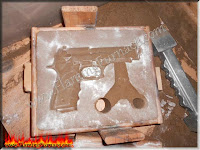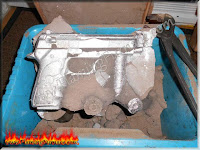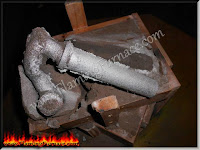Unfortunately I don't have a small CNC machine, something that I hope to buy or build one day. So my second option was to make the foundry patterns from A-Z.
As for the material for the patterns I decided to use 18mm MDF, and yes I know it's not a really "fun" material to work with but its easy to shape and for this type of pattern it was perfect.
So first I decided what radius to make the aluminum name plates, then I made a rough cut with a jig saw around the marked radios. From a previews job I already had a perfect circle cut so I used it as a template for all the name plates.
The next part was all done with my electric router, first I shaped the pattern into a perfect circle using a template and a router "Flush Trim bit", then I made another MDF Jig in order to create the pattern middle radius recess, for this job I used "Straight bit" + router collar.
After I created all the pattern inner circles (the same depth as the letters 3mm) I used a "Chamfer bit" to create a decorative 45° angle on the top side of the pattern.
After creating the pattern I covered the MDF with putty then sanded it to a smooth finish. After I got rid of the horrible MDF fiber texture it was smooth enough to stick to the foam letters. The last part was to give the patterns a few coats of paint and varnish. The paint and varnish really contribute to achieve a very good sand casting and aluminum casting results.
This first series of images illustrates the pattern making stages:
 |  |  |  |  |
 |  |  |  |
One mistake that I did was ramming the sand in the flask cope part to lightly as result there was a bit of a crack in the sand that I chose to ignore (mistake). The problem occurred when I was pouring the molten aluminum into the sand mould cavity. The molten metal lifted the sand up like a cake in the oven. What I should have done is create the cope part again or place some weight on top of the sand, that would of prevented it from rising. The casting defect that I have created is called "flash" and it could have been very easily avoided.
Next set of images are from the first casting session:
 |  |  |  |  |
The second casting was perfect with very good casting results.
Next sets of images are from the second casting session.
As this was a very good casting It didn't take me long too clean all the excess aluminum. Using metal file and electric sander I got it to a stage ready for polishing. For the polishing part one needs a lot of patience as it takes time to make it shiny. I used aluminum brown and blue buffing compound.
The end result was good enough for me and I gave it as a present to my work colleagues. Now they have a fancy paper weight for their desks :-)
This is a short video that I made of the aluminum name plates, creation stages:
 |  |  |  |  |  |
The end result was good enough for me and I gave it as a present to my work colleagues. Now they have a fancy paper weight for their desks :-)
 |  |  |  |

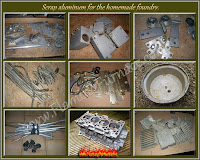







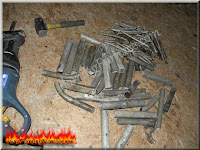



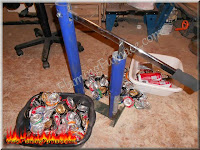

.JPG)



